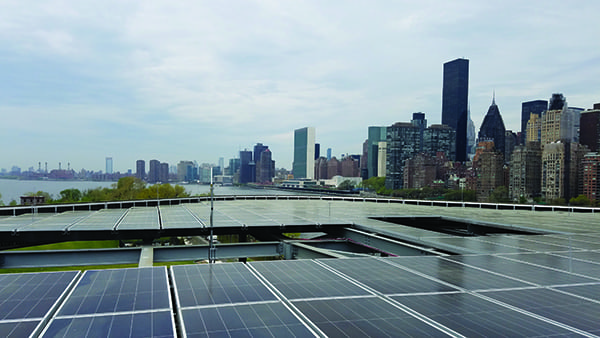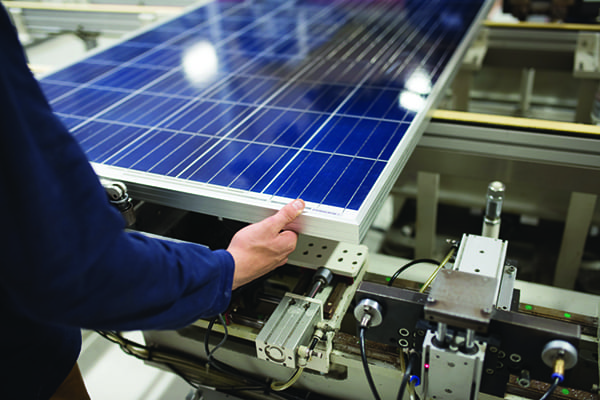Let the Sun Shine In: Where Is Solar Power Headed?
The Solar Energy Industries Association, the national trade association for the U.S. solar industry, reports that solar power has grown in the U.S. at a compounded annual rate of 59% since the solar investment tax credit was implemented in 2006. However, tariffs on certain products, including solar panels, could throw a wrench into solar power’s future prospects.
Roosevelt Island, a sliver of land in the East River next to Manhattan, is the home of Cornell Tech, an engineering campus of Cornell University that opened in September 2017. Its academic hub, the Emma and Georgina Bloomberg Center, was built with innovative architectural designs that feature many sustainable technologies, including solar power (Figure 1). Their electricity bill is $0, thanks to the solar panels high atop the roof that generate enough power to sustain the large and architecturally significant building.
The Cornell facility is emblematic of the growing demand for sustainable power. However, as solar manufacturing matures within an environment of changing world trade, the future of this technology and its supply and demand is not entirely clear.
With proposed tariffs and protections, domestic solar manufacturing could get a boost to meet new and stimulated demand. Speculators say that tariffs and tax incentives could translate to manufacturing gains in the U.S. and nearly double that capacity of solar power.
However, many have not been optimistic about the domestic supply of solar panels—mostly due to an oversupply. Goldman Sachs predicts that solar installations will decline by 24% in 2018; Credit Suisse anticipates a 17% decline. These analysts believe the fall will result from an oversupply, regardless of cheaper imports from China and other producing nations. Yet the cost of solar panels has gradually declined over the years, which helps commercial buyers like Cornell choose this power option.
Quality Boost
A contributing factor to the use of solar as a sustainable source of power is its efficiency. Efficiency is defined as the percentage of the sun’s energy that is converted through the panel into usable kilowatts of electricity. Suvi Sharma, CEO of Solaria, a solar panel manufacturer based in Oakland, California, whose panels were used in the Bloomberg building, reports that the average efficiency has been about 17% but is improving to about 20%; this makes the solar option an attractive source of energy.
Sharma noted that the efficiency increase is from the crystalline structure of panel materials. “Multicrystalline wafers and cells to monocrystalline wafers and cells; that’s the single biggest input on increasing efficiency of these systems,” he said.
Efficiency increase and some improvement in domestic manufacturing costs have helped make solar affordable. But the biggest influence, according to Sharma, has been low-cost imports from China. As he explains it, the increase in the installation of solar panels in the U.S. is driven mostly by low-cost Chinese manufacturing. China offers a combination of low cost and expectations of low profits.
“Some people call it ‘dumping of product,’ ” said Sharma, “But those low-cost solar panels have resulted in much lower-cost systems and therefore are much more affordable.”
Trade Relief?
According to a U.S. government fact sheet on trade relief via tariffs on certain products (including solar panels), Chinese national policy has enabled a plethora of Chinese imports. “From 2012 to 2016, the volume of solar generation capacity installed annually in the United States more than tripled, spurred on by artificially low-priced solar cells and modules from China,” says the report.
The fact sheet presents an explanation behind President Trump’s proposed safeguard tariffs for solar through a chronology. Crippling competition from China began in 2011, when China had subsidized its producers, making it possible for Chinese manufacturers to sell their solar products in the U.S. for less than their fair market value. The U.S. imposed antidumping and countervailing duties in 2012, but Chinese producers evaded the duties through loopholes and relocating production to Taiwan. In 2013, when U.S. producers petitioned trade representatives to close these loopholes, Chinese producers responded by moving production to countries such as Malaysia, Singapore, Germany, and Korea.
Nonetheless, solar imports still increased; from 2012 to 2016, they grew by 500%, and prices for solar cells and modules fell by 60%. This drove some U.S. manufacturers into bankruptcy or offshore to produce panels. This move greatly diminished the U.S. solar industry.
The International Trade Commission has recommended a tariff increase of 30% in year one, which began February 2018, 25% in year two, 20% in year three, and 15% in year four. The issue is in tumult with the threat of a looming trade war by importing nations. The certainty of the tariffs and their effect remains unclear.
“More than half of all raw materials needed to make solar panels come from China, and demand continues to rise around the world,” said Guillermo Wajner, co-founder of Greeneum, an energy trading platform based in Uruguay. “For some manufacturers, these materials could become harder to obtain at reasonable prices while tariffs are still in place in the U.S., India, and elsewhere.”
Wajner, though, is very optimistic about global demand. He said increased global demand for solar panels far outweighs any potential negatives. “As more and more countries around the world begin to realize the potential that renewable energy has, we hope the more than 1.1 billion people currently living in the dark, so to speak, will be able to take advantage of clean energy,” he said.
But like many, Wajner believes the near-term future of solar panels with regard to supply and demand “is anyone’s guess.”
Solar Niches
Sharma listed four market niches for solar panels in the U.S.: residential, commercial, utility, and off-grid.
The utility industry is one of the largest sectors. “If you look at a large-scale utility solar power plant, their greatest cost is the solar panel,” noted Sharma. “The cheaper that solar panel gets, the cheaper is the power produced. So, a big part of the growth in solar in the last five years has been in larger, utility-scale solar power plants that benefitted from inexpensive solar panels recently on the market.”
The commercial market has benefited, but not as much as the utility. Installing a solar system on a building, car court, or smaller system must take into account other costs, because other systems have to be integrated with the solar. Sharma referred to these as a “balance of system cost.” These costs can be significant. The solar panels may steal some of the total costs after the installation.
The off-grid niche includes communities that generate their own sustainable power and are off the main power grid. This is a small segment at this time but may be promising in future years.
In residential installations, the solar panel is a very small part of the overall system cost, generally about 15%, according to Sharma. “While this niche has expanded, it doesn’t grow that much because in spite of the low cost of the panel, the overall system cost has not declined in large numbers.”
The residential market enables energy-efficient homes to be built with solar panels; buyers seem to like them. The quality and efficiency of the panel may be custom designed for a specific need of the structure. What’s more, the panel may be “integrated” with the structure by making the photovoltaic cell (which converts solar energy to current) part of roofing shingles or the skin of buildings.
The residential niche remains lucrative for solar manufacturers that focus on it. “We already see that trend unfolding, and it presents an enormous opportunity for the advancement of energy efficiency in American homes,” said Scott Cramer, president of Go Solar Group, a full-service residential and commercial solar company headquartered in Salt Lake City, Utah. “As long as manufacturers tailor solutions to this demand, the future of domestic solar is bright, regardless of the regulatory state of affairs. The future of solar manufacturing hinges so tightly on agile delivery models, particularly those that fit the aesthetic and function of a smart home. From IoT [internet of things] to home security systems, windows, insulation, HVAC [heating, ventilation, and air conditioning] and more, solar success hinges on assimilating the value propositions into the broader home improvement context.”
In states like California, the state is helping promote the installation of solar panels in residential homes. In fact, they’re requiring it. California has enacted a new standard that’ll result in the installation of solar panels on all new in-state homes built after January 1, 2020.
For residential homes, panel aesthetics are a key factor in the solar purchase decision-making process; increasingly, there are high-density, highly aesthetic options available. Solar providers and builders are looking for ways to bring solar costs down even further, while giving more people greater, easier access to clean, reliable, affordable, and attractive solar.
More Than Just a Panel
According to Cramer, solar panels and panel manufacturing are only one dimension of the rise of solar power use. “Panel manufacturing itself is a small part of the quality in the solar manufacturing equation,” he said. “Advancements in inverter manufacturing, storage solutions, backup solutions, and battery backup solutions hold equal weight in helping homeowners and businesses alike get the most out of their systems, especially amid changing net-metering policies from utility companies.”
Sharma said it’s important not to view the solar panel as a commodity, where one is as good as another. That’s a common approach for the utility industry and the panels they buy. Instead, he emphasized the importance of differentiating panels on the basis of quality and efficiency (Figure 2).
“There’s great differentiation in the materials, the quality, and the systems that are used,” he explained. “It’s important for buyers of solar products to be discerning and make sure that they’re getting a high-quality product. Most people go solar because there’s some level of payback on it. That payback isn’t just in a year. It’s usually in five years and sometimes as long as 10.”
Solar power has made steady progress. Such progress will likely continue. The precise outcome of trade protections is unknown. The industry does have a rapid increase in the world’s adoption of solar power to hang its hat on.
“If you look back to the year 2000, you know, you had only a couple hundred megawatts of panel generating capacity installed,” said Sharma. “This year, you know, we’re reaching about 100,000 megawatts. That’s a phenomenal increase in size.” ■
—Jim Romeo (www.JimRomeo.net) is an engineer and copywriter focused on
business and technology topics.
The post Let the Sun Shine In: Where Is Solar Power Headed? appeared first on POWER Magazine.

